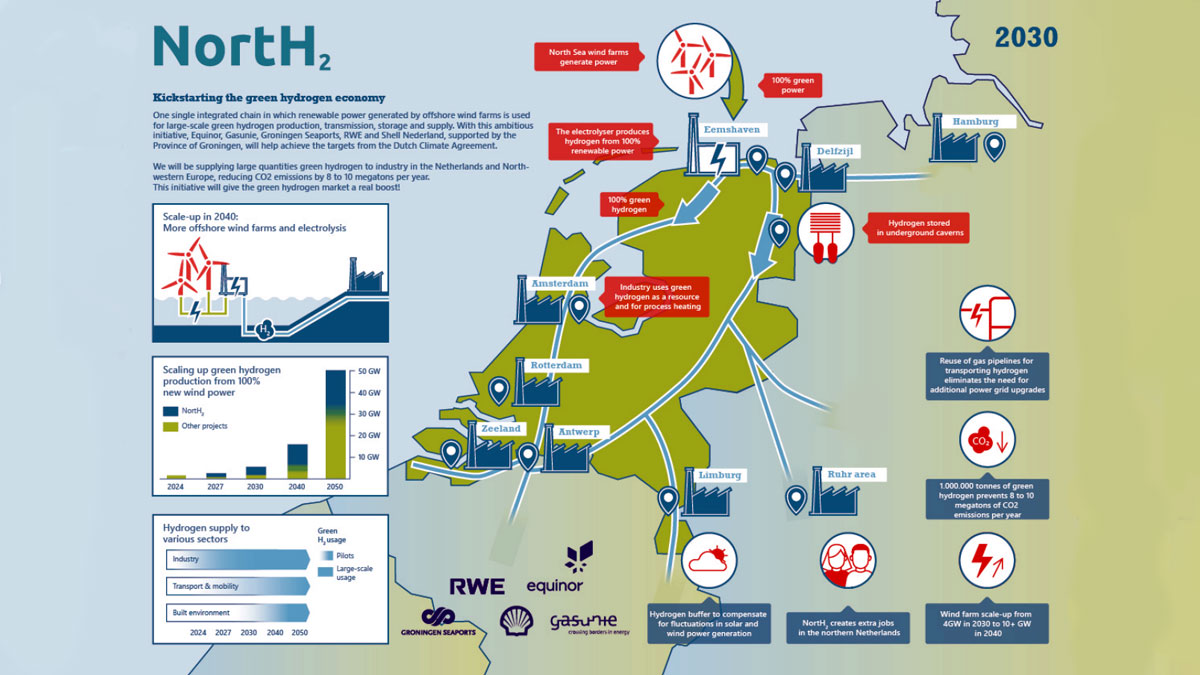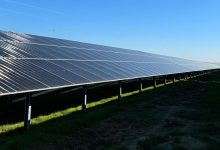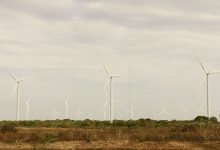Europe’s Largest Green Hydrogen Project: NortH2
Norwegian energy major Equinor and German utility RWE have joined the NortH2 green hydrogen project in the Netherlands. NortH2 project aims to produce green hydrogen using renewable electricity from offshore wind off the coast of Netherlands of about 4 gigawatts by 2030, and 10+ gigawatts by 2040, kickstarting the hydrogen economy in Northwest Europe.
“This is a ground-breaking project that Equinor is looking forward to contribute to. The project can be an important part in our efforts to build a competitive position in hydrogen, creating future value and industrial possibilities. Our aim is to be a net-zero energy company by 2050 and developing a profitable low carbon value chain for hydrogen will be an essential part of our transition to become a broad energy company. Hydrogen will be key to decarbonisation and net zero efforts for the energy market, especially in otherwise hard to abate sectors which cannot be served by electricity,” says Equinor CEO, Anders Opedal.
NortH2 was launched in February 2020, with Shell, Groningen Seaports Gasunie and the province of Groningen. Equinor joins RWE as new partners to the project. The project will complete a feasibility study by 2021, with the aim to start project development activities in the second half of 2021.
“As a new partner, RWE will contribute its broad expertise to create a powerful infrastructure for green hydrogen in Northern Netherlands. We are the world’s second biggest operator of offshore wind farms and have experience in the field of electrolysers, making us the ideal partner for NortH2,” adds Roger Miesen, CEO of RWE Generation.
The project will have a capacity of 1 GW in 2027, 4 GW by 2030 and 10+ GW by 2040 for electrolysis. This equates to 0.4. million tonnes of green hydrogen production in 2030 and 1 million tonnes green hydrogen production by 2040. This can abate 8 to 10 million tonnes of CO2 emissions. This is equivalent to the yearly emissions from road traffic in Norway. The rapid growth in offshore wind is well suited to developing a green hydrogen value chain.
“NortH2 fits well with Equinor’s experience and position as a leading offshore wind operator. Hydrogen will add to the competitiveness of renewables in the years to come, by adding value and an alternative route to market for renewables. The development of viable large-scale clean hydrogen value chains twill help meet the Paris agreement targets, mentions Pål Eitrheim, Executive Vice President New Energy Solutions in Equinor.
In recent months, the consortium has been working on the first phase of the feasibility study, focusing on the period up to 2030. The study concludes that NortH2’s integrated approach could lead to a 20% reduction in societal costs compared to a smaller-scale approach. Because the consortium wants to build the entire chain on a large scale – from offshore wind farms, production, storage, distribution to the eventual use of green hydrogen – this cost reduction can be achieved. In this way, green hydrogen can become an economically interesting decarbonisation option in, for example, the industry in comparison to alternatives.
According to a recent study by the University of Groningen, the project could involve between 700 and 1,200 structural jobs in the province of Groningen and a multitude of this during the construction phase. The second phase of the feasibility study focusing on the period after 2030 has now started.
“We are very pleased with RWE and Equinor joining the NortH2 consortium. This expansion of the consortium fits well with the international ambitions of the project. European collaboration is necessary to ultimately achieve the climate goals and accelerate the energy transition. In addition, RWE and Equinor are no strangers in the Eemshaven and the Northern Netherlands, and we can use each other’s knowledge and expertise to further develop Europe’s largest green hydrogen project,” says Cas König, CEO of Groningen Seaports.
Northwest Europe is well-positioned to develop an integrated hydrogen value chain – from offshore wind development and renewable power generation to production, storage, transport, and the sale of green hydrogen.
The North Sea has a great potential for large-scale wind development, there is extensive existing natural gas infrastructure that is suitable for storage and large-scale transport of hydrogen, and there are large industrial clusters in the Netherlands and Germany as well as heavy-duty vehicle OEMs that could economically benefit from a ‘first mover’ advantage.
NortH2 expands the energy transition agenda for Equinor by adding a significant green hydrogen value chain. This complements already existing renewable and low-carbon world-class projects like Dogger Bank (offshore wind), Northern Lights (CCS) and H2H Saltend (Blue hydrogen).
NortH2 sets a vision for 4 GW integrated offshore-wind-to-green-hydrogen value chain by 2030, and for 10+ GW by 2040. Through the parallel development of the required hydrogen infrastructure by repurposing existing natural gas infrastructure, the project could supply major Northwest European clusters.
By doing so the NortH2 project will make an important domestic contribution to meet expected quickly growing hydrogen demand and thereby to meet Dutch as well as EU climate targets for 2030. It also ensures long term decarbonisation in line with the Paris Agreement. The project fits well with the agenda of the Northern Netherlands to become a leading region for green hydrogen, supporting economic development and the creation of high-skilled jobs.
The consortium is dependent on permits from governments, the assignment of new wind farm locations in the North Sea, the available locations for the hydrogen plant(s), interest from potential customers, and the final investment decisions of the parties concerned.
NortH2’s partners anticipate that the initial project phases may potentially require European and national subsidies available for the decarbonisation of energy.







